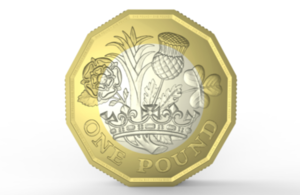Chancellor launches one year countdown to new £1 coin
The Chancellor announces that production of the new and highly secure £1 coin has now started.

The tails side of the new £1 coin
The new £1 coins started rolling off the production line at a rate of over 4000 a minute, as the Chancellor, George Osborne, announced that they would enter circulation in March 2017.
The current £1 coin is being replaced for the first time in over 30 years because of its vulnerability to sophisticated counterfeiters. The new 12-sided coin resembles the old ‘threepenny bit’ and will be the world’s most secure coin in circulation.
Chancellor of the Exchequer, George Osborne said:
I am delighted that the Royal Mint are now producing the most secure circulating coin anywhere in the world. With ground-breaking technology, developed in Wales, the new coin will help secure our economy and get rid of counterfeits. In a year’s time, the new coin, which will incorporate emblems from all four of our home nations, will line millions of pockets and purses around the UK.
Adam Lawrence, Chief Executive of The Royal Mint said:
As the Chancellor has announced today, the new coin will be going into circulation in March 2017, so that gives us a challenging but hugely exciting year to produce more than one billion brand new £1 coins. As an organisation we have been established for over one thousand years and we are proud to be recognised as the world’s best mint. In modernising the iconic £1 coin we are helping to re-define the world of coinage for the future.
Jonathan Hart, Chief Executive of the Automatic Vending Association said:
The AVA and The Royal Mint have been working together for a number of years to ensure implementation of the new one pound coin proceeds as smoothly as possible.
Whilst we can’t hide from the fact there is a sizeable piece of work for our members to undertake to ensure readiness, as an organisation we completely understand and support the rationale and the need for a new, secure, one pound coin in the United Kingdom.
Levels of counterfeit £1 coins have been as high as 3% in the past few years, equating to around 45 million coins. The new, highly secure coin will reduce the costs of counterfeits to businesses and the taxpayer.
HM Treasury and The Royal Mint also announced today details of how the coin will be introduced into circulation. It has been confirmed that the new coin will be introduced in March 2017 and that there will be a six-month period of co-circulation, where the current £1 and the new £1 coins will both be in circulation.
As with any re-coinage, all businesses that handle cash need to plan and prepare for the introduction of the new coins.
The Royal Mint will continue to work with key industries and businesses during the introduction phase of the new £1 coin, and an awareness and education campaign is planned to assist businesses to ensure a seamless and smooth transition to launch in 2017.
The new £1 coin was announced by the Chancellor at Budget 2014, and the design of the new coin was announced at Budget 2015.
David Pearce, 15 at the time, and a pupil at Queen Mary’s Grammar School in Walsall, beat off fierce competition to be selected as the coin’s designer. His winning design was chosen following a public competition organised by The Royal Mint on behalf of Her Majesty’s Treasury which saw over 6,000 entries. The Royal Mint is based in Llantrisant, South Wales. Its roots extend back some 1,000 years and today The Royal Mint employs more than 850 people.
The new coin has a number of features which make it the most secure coin in the world. These features include:
- 12-sided shape, with rounded edges (‘radial chords’) and corners
- Bi-metallic composition of two colours
- Additional security features, including The Royal Mint’s new anti-counterfeiting technology, milled edges and a latent image
Following extensive final bulk production testing, the final specification has now been confirmed:
- Diameter: Maximum (point to point) 23.43mm; minimum (edge to edge) 23.03mm
- Edge thickness: 2.8mm
- Weight: 8.75g
- Metallic composition: Nickel-brass outer; nickel-plated homogenous non-ferrous inner